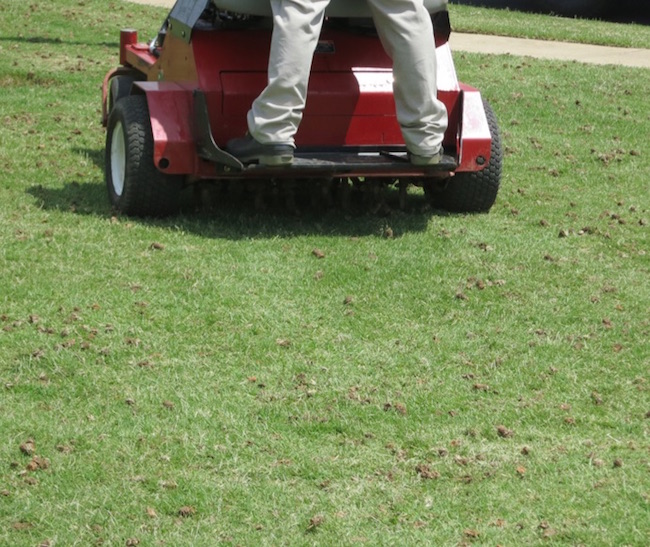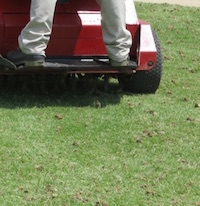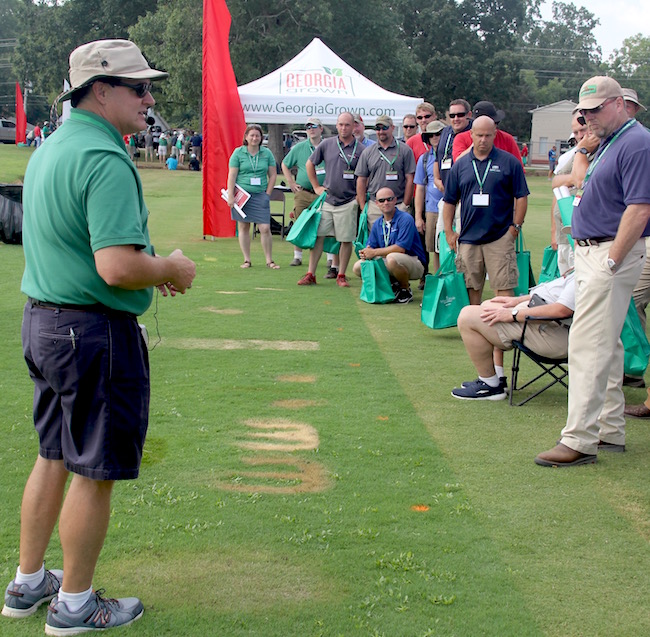Last year many lawns across the state didn’t receive enough rainfall for the grass to grow, photosynthesize and make carbohydrate reserves. Turfgrass that experienced this lack of rainfall will likely be slow to green up this spring. If rainfall totals return to normal this spring, lawns will recover, but may do so at a slower rate because the production of reserves was compromised last fall. For example, a lawn that would typically be fully green and growing in mid-May might take until late May or June to green up. A two- to four-week delay in green-up of warm-season grasses may be common this spring.
Consider aerification to improve green-up and growth. Core aerification is a cultivation practice that opens the soil, allowing moisture and air into the root zone. When it’s timed and performed correctly, aerification can stimulate rhizomes to initiate growth, causing the grass to grow sooner.
Aerification never hurts, but most warm-season lawns do not need regular or annual aerification. This spring may be an exception. Core aerification stimulates the turfgrass’s growth and helps the turfgrass achieve surface coverage as early as possible. It benefits lawns that suffered through one, or multiple, drought-induced dormancy periods last summer and fall. If there is a year to seriously consider core aerification, this is it.
Core aerification also benefits centipedegrass and St. Augustinegrass, even though these plants do not have rhizomes. While the practice does not stimulate shoot growth from rhizomes, aerification does relieve compaction, which generally stimulates rooting and promotes deeper roots that pull water and nutrients from a greater soil volume. For turfgrass species that have stolons, aerification typically increases lateral growth and creates a healthier plant.
There are two basic types of aerification: hollow- and solid-tine. Hollow-tine aerification removes a soil core, and solid-tine aerification creates a hole without removing a soil core. In both types, a void in the soil is created that allows air and water to more deeply penetrate the root zone.
Hollow-tine aerification’s benefits last longer due to the removal of the core. With either technique, the deeper the aerification holes, the better. Ideally, cores, or plugs, are 3 to 4 inches in depth and a half-inch in diameter.
In time, the surrounding soil relaxes back into the void, opening pore space in the surrounding soil, which leads to improved air exchange and better water infiltration within the soil. If there is a choice between hollow-tine and solid-tine aerification, choose hollow-tine.
Stimulating turfgrass through aerification can also make the grass more sustainable. Once turfgrass has leaves, it can begin photosynthesizing and producing carbohydrates. The plant will use some of these reserves in the spring and summer, and some will be partitioned to rhizomes and stolons. Restoring carbohydrate reserves that may have decreased as a result of 2016 conditions will help the grass make it through the next stressful condition.
Soil wears on metal tines. To optimize the benefits of core aerification, tines should be changed regularly, especially once they cannot effectively pull a 3-inch core. If you choose to rent an aerifier and do the job yourself, inspect the tines and choose the piece of equipment with longest tines or ask the rental agency to replace the tines with a new set.
Core aerification is only part of a sound agronomic program. Other basic turfgrass management practices, like maintaining proper fertility of the turfgrass, are also important.
Keep in mind that turfgrass is likely less vigorous this spring as a result of last summer’s weather conditions. Avoid applying nitrogen fertilizer to warm-season grasses until soil temperatures at the 4-inch depth are consistently 65 degrees Fahrenheit and rising. (This will likely coincide with the appropriate timing for core aerification.)
To make sure soil pH, phosphorus and potassium levels are within recommended ranges for optimum growth, take a soil sample to your local University of Georgia Cooperative Extension office.
Visit www.GeorgiaTurf.com to find lawn care calendars, including fertility recommendations, for different turfgrass species.









